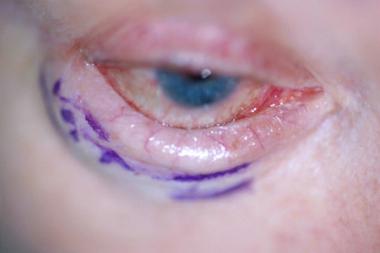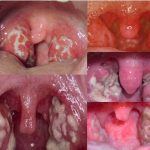Trichiasis
What Is Trichiasis?
Trichiasis is an eyelid condition that is characterized by misalignment of eyelashes, which grow internally in the direction of the eye. As these lashes develop, they cause friction against parts of your eye leading to irritation in the eyes. The lashes rub against the following: conjunctiva, which is a thin membrane that encloses the sclera, the white part of the eye; cornea, which envelops the iris and pupil1. Trichiasis, can occur in ages but it affects adults more.

Fig. Trichiasis affecting the eyelashes
Causes
A number of factors and medical conditions can trigger trichiasis. They include
Trachoma
It is an infection that affects both of your eyes and can lead to blindness. Chlamydia trachomatis bacterium causes trachoma. This condition is known for impairing vision in many people globally and can cause permanent blindness in those who are affected. World health organization has documented that trachoma is responsible for impaired vision of nearly 2.2 million people and 1.2 million of them become totally blind.
Once you are exp osedto Chlamydia trachomatis bacterium, it attacks your eyes in the early phase and causes your eyes to become irritated, a condition known as conjunctivitis or pink eyes. This causes your eyes to swell and become red. In some cases, a discharge comes out of your eye that is sticky. Pink eyes can occur in both or one eye and can be transmitted from one person to another.
Conjunctivitis can be caused by the following
- Viral infection– Viruses can affect your eyes and cause pink eyes, a type of Conjunctivitis known as viral Conjunctivitis. Viral Conjunctivitis is infectious and the virus can spread to people living in congested places through contact with infected persons. This infection causes your eyes to appear as if they are burning and become red. In some cases, people affected with this infection can notice a watery discharge coming out from their eyes.
- Bacterial infection– Bacteria also contributes to conjunctivitis, a condition called Bacterial conjunctivitis. When you have bacterial infection, your eyes become red and tender with sticky pus.
- Allergic reaction– Conjunctivitis can also arise from allergic reaction to chemicals and other substances. It causes irritation and redness in your eyes and watery discharge coming out of the eyes.
As trachoma advances, it distorts your vision and causes pain in the eyes. If this infection is left untreated for a longer period, it causes scarring within your eyelids and the eyelashes turns internally towards the eye.
The eyelashes rub against your cornea and can turn it cloudy if irritation continues. This can lead to loss of vision in your eyes as well as corneal ulcers, which is an ulcer that forms on your cornea.
Epiblepharon
This is an inherited skin condition. It makes the skin around your eyes to become loose and form folds. These folds cause your eyelashes to be in an upright position and can rub against your eyes leading to irritation.3
Herpes zoster
This is an eye condition caused by a virus called shingle. This infection cause severe inflammation in tissues of your eyes. In severe cases, this infection can lead to scarring in your eyes which can lead to loss of vision.
Eye trauma
Injuries to the eye can also contribute to trichiasis. For example if you are accidentally burned by fire or hot fluids in your face, your eyes can also be affected; your eyelid can become swollen and painful.
Blepharitis
This is a condition where your eyelids become swollen or inflamed and reddish. This occurs when bacteria and oil flakes develop at the bottom of your eyelid.
Normally, every person has some bacteria on their skin. However their distribution on the skin can vary among people. Some people can have many bacteria at the bottom of their eyelids than others. Presence of bacteria can lead to formation of flakes at the base of your eyelid.
People who have malfunctioned oil glands in their eyelids can also develop blepharitis. This condition is also common in people with dry eyes and a fatty skin.4
Stevens-Johnson syndrome
This disorder that affects your skin and mucous membrane. It occurs when you react to certain medicines or as a result of an infection on your skin. This disorder starts as flu and progresses into severe purple or red rashes that can spread on your skin. It then forms blisters on your eye, mouth and nose.5
Symptoms
People with trichiasis experience irritation in their eyes. Their eyes can become red and are more sensitive to bright light.
Diagnosis
Trichiasis can be diagnosed through a physical test and other clinical examination. In physical exam, your doctor checks for swellings and redness in your eyes.
Your doctor can also use a slit lamp test to identify problems in your eyelids and other parts of your eye. In this exam, your puts fluorescent dye in your eyes to dry the tears and uses a microscope and a slit lamp with high intensity to view your eye.
Additional tests are also needed to rule out other similar eye conditions.
Treatment
Trichiasis can be managed by removing the affected eyelashes, follicles or both of them. This depends on whether single or multiple eyelashes are affected. The following treatment options can be used:
Surgery
Your ophthalmologist can suggest the following surgery procedures to remove the eyelashes
- Ablation- This a procedure that involve the use of lasers or radiofrequency waves to extract lashes and follicle. Your doctor will administer a numbing medication to you to reduce pain and make you feel ease during the procedure.
- Cryosurgery6– This is a procedure where freezing temperatures are used to eliminate an abnormal tissues in your body. Liquid nitrogen, argon and carbon dioxide can be used in this procedure. Before this procedure, your doctor will give you all the instruction to follow to ensure surgery is successful.
During the procedure, your doctor places liquid nitrogen, carbon dioxide or argon on your eye skin using a spray. You will be given an aesthesia to relieve pain and make you comfortable during the procedure. This procedure freezes the lashes and follicles and destroys the cells.
However, cryosurgery can cause undesirable complications to you. These risks include:
- Surrounding tissues of the eyelid can be damaged.
- It can also cause infections
- It can lead to scarring of the eyelashes.
- It can also cause ulcers in the cornea.
Electrolysis
In this procedure, your doctor uses low voltage electric current and short waves to remove lashes and follicle. Electrolysis can cause minimal damage on your skin as well as make you feel uneasy during the procedure.
Reference List
- Trichiasis. http://www.merckmanuals.com/home/eye-disorders/eyelid-and-tearing-disorders/trichiasis
- https://www.aao.org/eye-health/diseases/what-is-trichiasis
- http://vaeyecenter.com/caring-for-your-eyes/common-eye-diseases/trichiasis/
- Blepharitis. https://www.aao.org/eye-health/diseases/what-is-blepharitis
- Stevens – Johnson syndrome. http://emedicine.medscape.com/article/1197450-overview#a3
- Cryosurgery. http://www.healthline.com/health/cryosurgery#overview1
- Trachoma. https://www.aao.org/eye-health/diseases/what-is-trachoma






